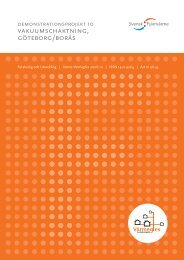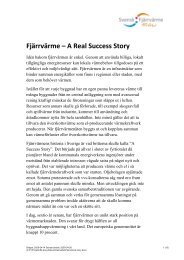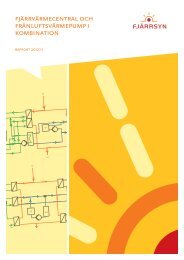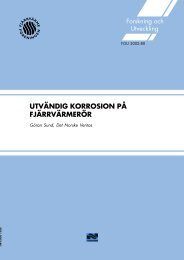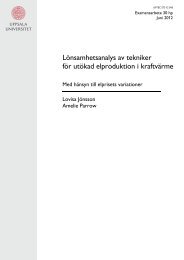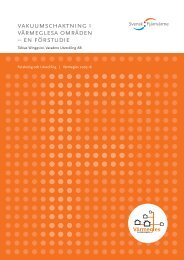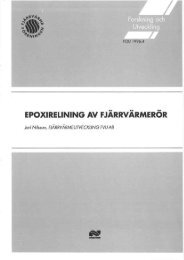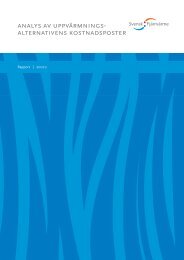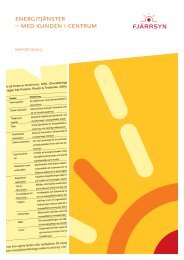Ladda ner dokumentet - Svensk Fjärrvärme
Ladda ner dokumentet - Svensk Fjärrvärme
Ladda ner dokumentet - Svensk Fjärrvärme
Create successful ePaper yourself
Turn your PDF publications into a flip-book with our unique Google optimized e-Paper software.
<strong>Svensk</strong> <strong>Fjärrvärme</strong> AB │ December 2005 Tillverkning och besiktning av fjärrvärmesystem 2005:3<br />
9.3. Guideline 2/4. Guideline related to: Article 1 Paragraph<br />
2.1.1 , Article 1 Paragraph 2.1.2<br />
Question: Which type of pressure equipment is a heat exchanger ?<br />
Answer: Heat exchangers are considered to be vessels.<br />
As an exception, heat exchangers which consist of straight or bent pipes<br />
which may be connected by common circular header(s) made also from<br />
pipe are classified according to Article 1 paragraph 2.1.2 last sentence<br />
as piping if, and only if, the 3 following conditions are met:<br />
- air is the secondary fluid,<br />
- they are used in refrigeration systems, in air conditioning systems or in<br />
heat pumps,<br />
- the piping aspects are predominant.<br />
For such heat exchangers with headers, the piping aspects are predominant<br />
if Catp ≥ Catv where:<br />
Catp = Abstract category that would be applicable according to<br />
97/23/EC if the heat exchanger were classified as piping using DN of<br />
the biggest header.<br />
Catv = Abstract category that would be applicable according to<br />
97/23/EC if the biggest header, without the connecting piping, were<br />
classified as a vessel (i.e. for determining Catv, not the total volume V<br />
of the heat exchanger is taken into account, but only the volume VH of<br />
the biggest header).<br />
When the result is Catv>Catp, the appropriate vessel classification shall<br />
be determined by using the volume of the entire heat exchanger<br />
(headers plus connecting tubes).<br />
The abstract category approach for determining the predominant aspect<br />
is limited to this specific application dealt with in Article 1 paragraph<br />
2.1.2. The use of this concept outside this context is not supported by<br />
the directive and thus is not permissible.<br />
Note: Piping heat exchangers which do not meet the requirements of the<br />
exception are not to be classified according to the last sentence of<br />
Article 1 paragraph 2.1.2 as piping; they are to be classified as vessels.<br />
For example:<br />
- Heat exchangers which are not used in refrigeration systems, in air<br />
conditioning systems or in heat pumps, and for which the main purpose<br />
is to heat or cool the contained fluid by using the surrounding air;<br />
- Half-pipe coil or a similar « jacket » construction that heat or cool a<br />
vessel;<br />
- Pipe coil that is inside a vessel to heat or cool its content.<br />
Remarks: Swedish reservation on the determination of Catv based only on the<br />
biggest header and not on the sum of the header volumes, and on the<br />
inclusion "refrigeration systems" and condensers in the second indent of<br />
the answer.<br />
│ 39





